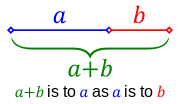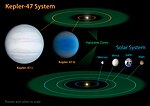Kepler-39 (2MASS J19475046+4602034) is an F-type main sequence star located in the constellation Cygnus. It is located about 3,500 light-years (1,070...
5 KB (284 words) - 20:48, 2 May 2024
Kepler-186f (also known by its Kepler object of interest designation KOI-571.05) is an Earth-sized exoplanet orbiting within the habitable zone of the...
32 KB (3,103 words) - 14:39, 23 August 2024
List of multiplanetary systems (redirect from Kepler-55)
with the most confirmed planets are the Sun (the Solar System's star) and Kepler-90, with 8 confirmed planets each, followed by TRAPPIST-1 with 7 planets...
263 KB (8,775 words) - 15:54, 5 October 2024
system via NASA's Kepler space telescope in 2012. In November 2013, evidence of a third planet orbiting between the planets b and c, Kepler-47d, was announced...
22 KB (2,132 words) - 06:23, 22 December 2023
Kepler-42, formerly known as KOI-961, is a red dwarf located in the constellation Cygnus and approximately 131 light years from the Sun. It has three known...
12 KB (832 words) - 11:51, 9 May 2024
temperature of 5829 Kelvin and a luminosity of 1.39 times the solar luminosity. Kepler-385 was observed by the Kepler space telescope, which initially detected...
7 KB (471 words) - 19:30, 20 September 2024
Kepler-452 is a G-type main-sequence star located about 1,810 light-years away from Earth in the Cygnus constellation. Although similar in temperature...
13 KB (1,189 words) - 08:01, 9 May 2024
Kepler-9. Kepler-9c and Kepler-9b were the first exoplanets confirmed to be transiting their star. The planet's discovery was announced by the Kepler...
9 KB (765 words) - 19:30, 22 December 2023
Kepler-16 is an eclipsing binary star system in the constellation of Cygnus that was targeted by the Kepler spacecraft. Both stars are smaller than the...
9 KB (489 words) - 10:30, 9 May 2024
Kepler-296e (also known by its Kepler Object of Interest designation KOI-1422.05) is a confirmed super-Earth exoplanet orbiting within the habitable zone...
9 KB (854 words) - 22:42, 10 February 2024
Kepler-186 is a main-sequence M1-type dwarf star, located 177.5 parsecs (579 light years) away in the constellation of Cygnus. The star is slightly cooler...
17 KB (1,540 words) - 14:41, 23 August 2024
Kepler-62 is a K-type main sequence star cooler and smaller than the Sun, located roughly 980 light-years (300 parsecs) from Earth in the constellation...
17 KB (1,612 words) - 05:28, 23 August 2024
This is a partial list of exoplanets discovered by the Kepler space telescope, running from star number 1 through 500, inclusive. All lists: 1–500 501–1000...
170 KB (2,916 words) - 06:55, 29 June 2024
Earth's perspective, is 14.87. Therefore, Kepler-70 is too dim to be seen with the naked eye. Kepler-70 is an sdB (B-type subdwarf) star with a temperature...
12 KB (1,094 words) - 18:13, 23 August 2024
Pepe (footballer, born 1983) (redirect from Kepler Laveran Lima Ferreira)
Kepler Laveran de Lima Ferreira ComM (born 26 February 1983), known as Pepe (Brazilian Portuguese: [ˈpɛpi], European Portuguese: [ˈpɛpɨ]), is a former...
74 KB (5,997 words) - 12:08, 6 October 2024
planets, though it remains speculative whether such 'moons' really exist. The Kepler telescope might be sensitive enough to detect them. But there is evidence...
35 KB (2,706 words) - 19:05, 3 August 2024
Page: Kepler-296 f". NASA Exoplanet Archive. NASA Exoplanet Science Institute. Retrieved 4 June 2016. "Confirmed Planet Overview Page: Kepler-452 b". NASA...
57 KB (3,065 words) - 12:47, 9 October 2024
Kepler-1649c is an Earth-sized exoplanet, likely rocky, orbiting within the habitable zone of the red dwarf star Kepler-1649, the outermost planet of...
10 KB (885 words) - 21:09, 14 January 2024
Kepler-1652b (also known by its Kepler Objects of Interest designation KOI-2626.01) is a super-Earth exoplanet, orbiting within the habitable zone of the...
7 KB (772 words) - 11:10, 16 June 2024
Kepler-186e (also known by its Kepler Object of Interest designation KOI-571.04) is a confirmed exoplanet orbiting the red dwarf star Kepler-186, approximately...
11 KB (988 words) - 05:20, 23 August 2024
Golden ratio (redirect from A+b is to a as a is to b)
University of Tübingen in a letter to Kepler, his former student. The same year, Kepler wrote to Maestlin of the Kepler triangle, which combines the golden...
113 KB (12,926 words) - 03:56, 6 October 2024
Circumbinary planet (redirect from MXB 1658-298 b)
PH1b (Planet Hunters 1 b), a circumbinary planet in a quadruple star system. In 2015, astronomers confirmed the existence of Kepler-453b, a circumbinary...
53 KB (5,613 words) - 07:02, 28 August 2024
times that of Earth, Kepler-445c is likely a mini-Neptune with a volatile-rich composition, and has been compared to GJ 1214 b. Kepler-445d is only slightly...
6 KB (348 words) - 02:01, 27 September 2023
southeast is the crater Encke. Kepler is named for the 17th century German astronomer and mathematician Johannes Kepler. Kepler is most notable for the prominent...
7 KB (555 words) - 16:22, 22 August 2024
Kepler-47b (also known as Kepler-47 (AB) b and by its Kepler Object of Interest designation KOI-3154.01) is an exoplanet orbiting the binary star system...
9 KB (749 words) - 08:45, 10 April 2024
In celestial mechanics, a Kepler orbit (or Keplerian orbit, named after the German astronomer Johannes Kepler) is the motion of one body relative to another...
42 KB (5,982 words) - 18:04, 20 December 2023
Kepler-1708b (previously known as KIC 7906827.01) is a Jupiter-sized exoplanet orbiting the Sun-like star Kepler-1708, located in the constellation of...
14 KB (1,222 words) - 13:42, 20 August 2024
Kepler-1625b I, a possible moon of exoplanet Kepler-1625b, may be the first exomoon ever discovered (pending confirmation), and was first indicated after...
7 KB (600 words) - 04:26, 29 July 2024
more than twice as dense (about 12.6 g cm−3) as the innermost exoplanet Kepler-107 b (about 5.3 g cm−3). Vallenari, A.; et al. (Gaia collaboration) (2023)...
7 KB (462 words) - 13:20, 9 May 2024
of its planets. Kepler-51 has four planets, discovered between 2013 2024. The first planets discovered in the system were Kepler-51 b, c and d, detected...
11 KB (997 words) - 18:07, 5 October 2024


















